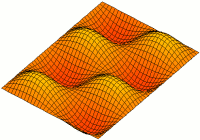Resonator facts for kids
A resonator is a special device or part of something that helps make a sound or vibration much stronger. Think of it like an echo chamber for energy. When something vibrates at a certain speed, the resonator can make that vibration much bigger and louder.
This happens because the resonator is designed to naturally vibrate at that same speed, a bit like pushing a swing at just the right time to make it go higher.
How Resonators Work
Resonators in Electronics
In the world of electronics and radio waves, a cavity resonator is like a special box or space. This space is usually surrounded by materials that don't conduct electricity well, like a dielectric, or by metal.
These cavity resonators are designed to let certain radio waves or electromagnetic vibrations bounce around inside them. They create "standing wave patterns" at specific speeds, which are called eigenmodes. The size, shape, and material of the cavity decide exactly which speeds of waves will become stronger. These are used in many electronic devices, like microwave ovens and radio transmitters.
Resonators in Music
Most musical instruments have resonators. These are the parts that make the sound much louder so you can hear it clearly. Without them, the sounds would be very quiet.
For example, a vibraphone has long tubes underneath its keys. These tubes are resonators. When you strike a key, the sound travels into the tube and becomes much louder. Some vibraphones also have a special motor that quickly opens and closes these tubes. This creates a cool, trembling sound effect.
The main body of a violin is also a resonator. When the strings of a violin vibrate, they make a very soft sound on their own. But the vibrations travel through the bridge into the wooden body of the violin. The body then vibrates and makes the sound much louder and richer. It's similar to how an elastic band stretched between your fingers makes very little sound when plucked, but if you stretch it over a box, the sound gets louder.
Images for kids
-
These are RF cavities in the linac of the Australian Synchrotron. They help speed up and group together beams of electrons. The linac is the tube going through the middle.
See also
 In Spanish: Resonador para niños
In Spanish: Resonador para niños






